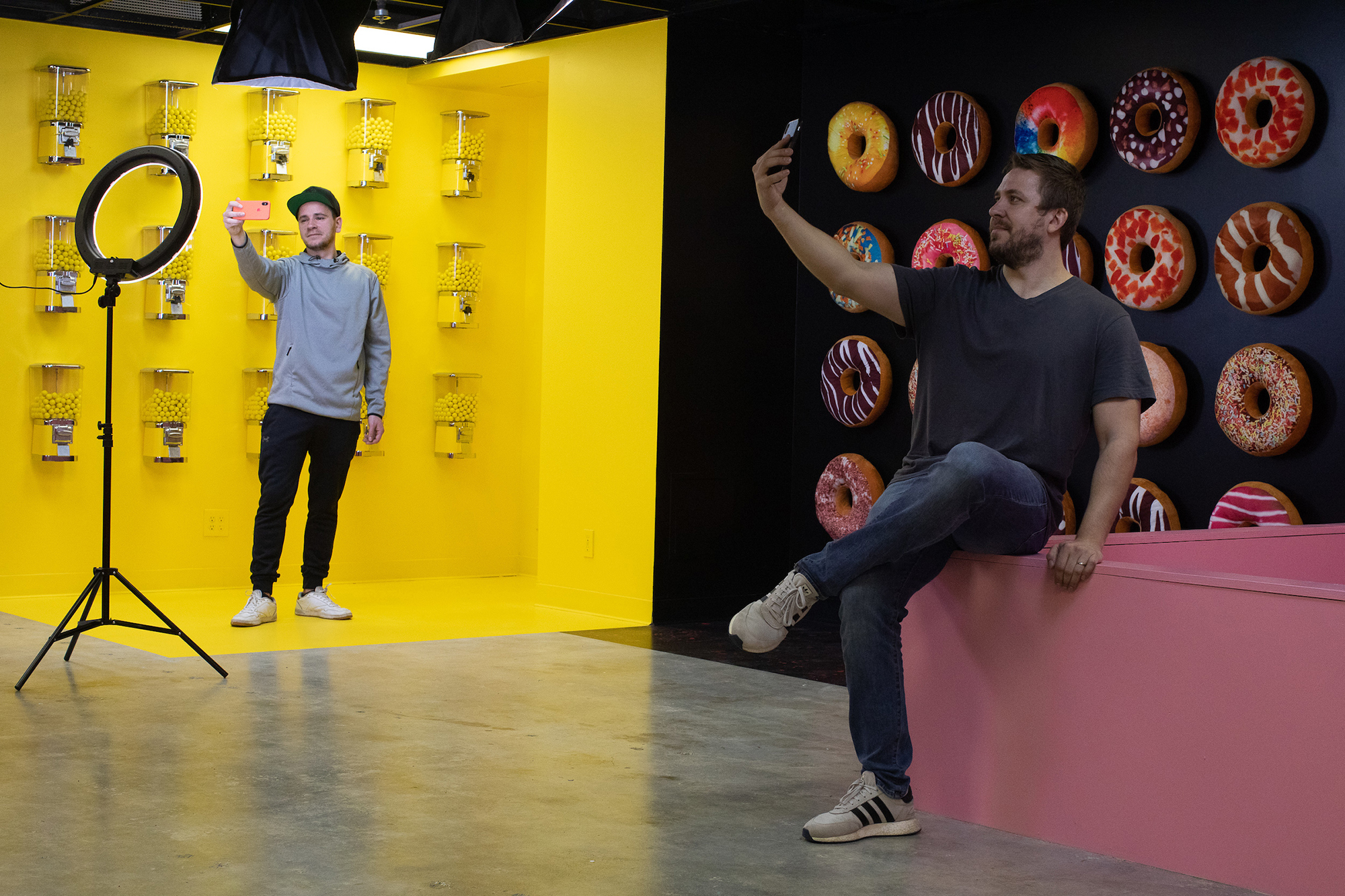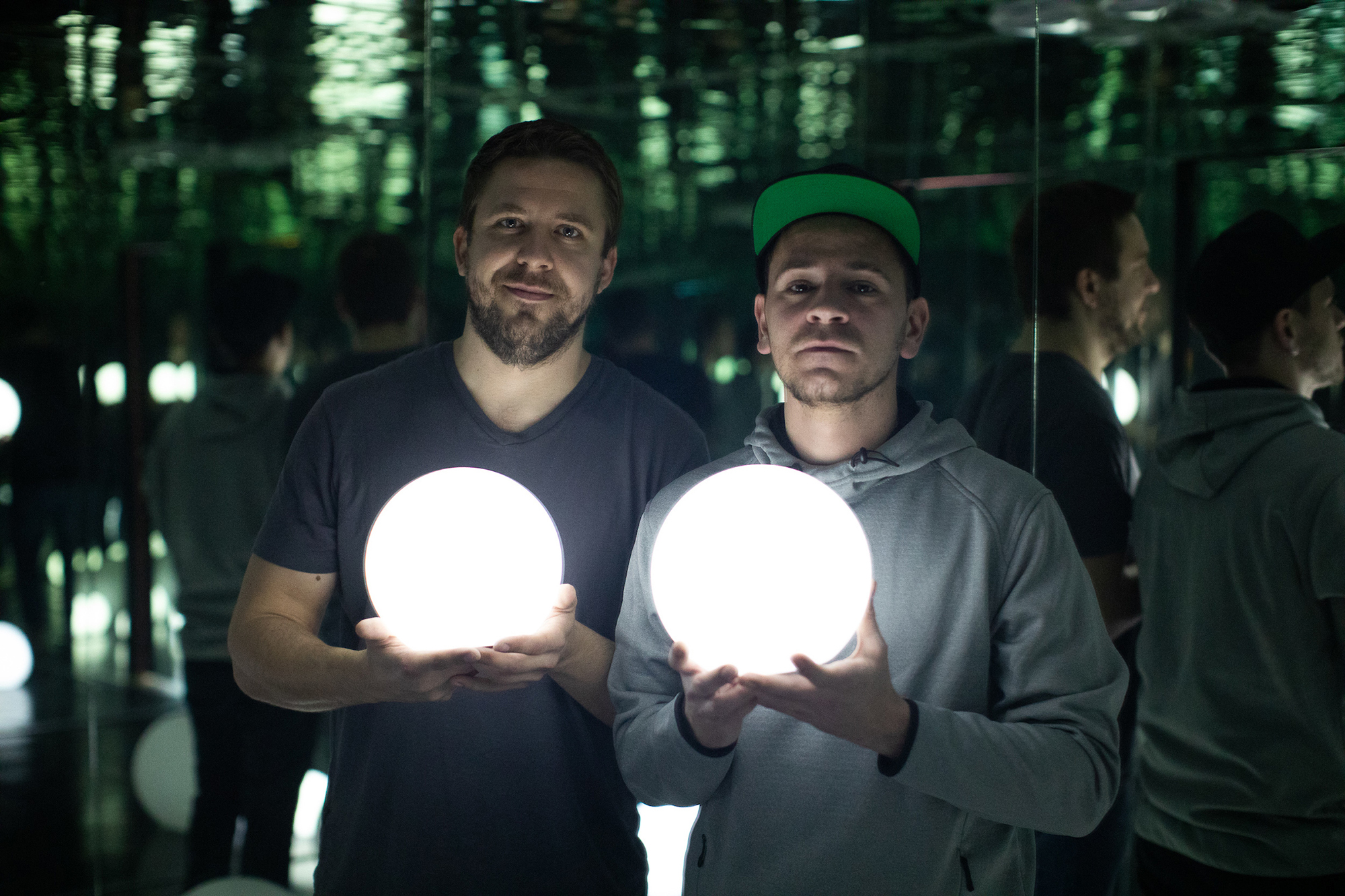The floor of one of the cubicles is covered with artificial grass, the blades a bright emerald green. The rug’s ragged edges suggest a hurried cutting job. It doesn’t even pretend to resemble real grass.
Nearby, a ball pit full of mauve plastic spheres quietly awaits interaction, along with the faux-vintage rotary phones attached to the wall. Above an orange inflatable couch, a neon sign screams “I CAN’T CONTROL MY SELFIE.”
Welcome to the Selfie Museum, where visitors will soon seize the few-dozen candy-colored booths to craft the perfect Instagram shots. There are no placards displaying artist names or dates, no security guards telling you to back off, only aides who ensure the ring light (the preferred selfie light) nicely illuminates your features. At this museum, for roughly $30, the visitor is the masterpiece — at least for the allotted 60 minutes.
“When somebody's taking a picture of you, you become a piece of art within the installation,” says Igor Benchak, one of the founders of the Selfie Museum, standing in front of the “flower cave” full of fake grass and pastel-tinted roses. The Seattle Selfie Museum, which has a Denver counterpart, opens Saturday to “influencers, photographers, friends and creatives,” and to the public on Sunday. It will stay there for at least six months, depending on its popularity.

“Even though it's called Selfie Museum, it's designed for people taking all kinds of pictures, hopefully of each other, interacting,” says Benchak’s business partner Alex Kurylin (who once operated a chain of escape rooms in cities including Seattle).
With this concept, the Denver-based duo jumps on the bandwagon of a new generation of profitable and popular Instagram factories.
In the saccharine Museum of Ice Cream in New York and San Francisco, visitors can dip themselves into a swimming pool of rainbow sprinkles. At the Color Factory in Houston, large blinking letters on a sign spell out “You Are Magic.” Wine-tasting meets selfie-making and a lot of pale pink backdrops in Manhattan's Rosé Wine Mansion, while in The Museum of Pizza in Brooklyn, you can strike a pose amidst gooey drops of cheese. And at Candytopia in Philadelphia, the ball pit is filled with “marshmallows.” You get the picture. And the picture is the whole point.
The Selfie Museum doesn’t beat around the bush when it comes to its core theme. Even the bathrooms double as a backdrop. In the restrooms everything is Pepto-Bismol pink, from the roses on the walls to the wig on the makeup table, not to mention the walls and the table themselves. “It looks very good in pictures,” Kurylin says. “No matter what you wear, if you have pink backdrop, you'll look good.”
“People bring suitcases with different clothes so they can change for a different installation,” Kurylin explains. “They have different outfits, dresses. This would be a changing room, but there’s also a lot of photo opportunities.”
“Those,” says Kurylin, continuing the tour and pointing to a couple rows of record-sized donut pillows on the wall, “are just beautiful donuts.”
“Wings: classic,” says Benchak. He’s referring to two sets of human-sized feathered wings attached to a blank wall, perfect for standing in front of while posing. “Everybody likes wings.”
The duo built most of the installations themselves. They sourced faux-rotary phones from eBay, black and golden wings from AliExpress, and furniture from IKEA, Amazon and thrift stores, the last of which was given a coat of emergency orange paint for a monochrome immersion.
Artists have long used ready-made, store-bought and cheap materials to create art. But here, it feels less like creative ingenuity, merely a means to a photographic end.
"May the selfie forever reign!" is the Selfie Museum's unofficial motto. Artist Ertan Atay captures the social phenomenon with his digital collage of famous women in art history -- Botticelli's Venus, artist Frida Kahlo, the Mona Lisa and Vermeer's Girl with Pearl Earring -- taking, you guessed it, a selfie. (Matt M. McKnight/Crosscut)
“We consider all of our installations artwork," Benchak says.
Does calling it art make it art? Maja Petrić, a Redmond-based artist renowned for immersive, photo-worthy installations, is not so sure. “What I consider immersive art is an installation that is engaging on a multisensory level, that is expanding people's emotional experiences and is meaningful in one way or another,” she says.
For her 2018 installation We Are All Made of Light at MadArt, Petrić created a forest of dangling lights on which she, using artificial intelligence, projected video recordings of people’s silhouettes moving through the work at intervals. With it, she says, she hoped to expand the technology’s options and foster connection.
Not every installation artist, Petrić adds, works in that vein. Others are focused on critical analysis of society or technology. But “if the only meaning is to take a selfie, it's hard to call it art. It seems very oriented towards consumerism,” Petrić says.
Benchak and Kurylin disagree. At the Selfie Museum, they invited artists (including local muralists Malt Bizney and T H E Y D R I F T) to cover a handful of installations and the outside stairwell with graffiti-style murals. Artist Joe Palec covered a booth in a squiggly, black-and-white cartoon fantasy land, titled “Inside of Joe’s Mind.” But there’s no placard pointing to the artwork’s provenance.
Upstairs, in the only closed-off room, another plaque seems to be missing — that of Yayoi Kusama. Benchak and Kurylin’s dim, mirror-clad room filled with colorful sphere-shaped lamps is eerily reminiscent of the esteemed Japanese artist’s “Infinity Mirrored Rooms,” which were on view at the nearby Seattle Art Museum 2½ years ago (and are permanently on view at the Broad Museum in Los Angeles). Kusama, whose work grapples with trauma, suicide and mental health, debuted her “Mirror Rooms” in the 1960s not for selfie-making, but based on a desire to fade away in an infinite universe of lights.
Here, the room feels cold and empty, not an expression of Kusama’s personal struggles and vision, but an endless vacuum for the visitors to express themselves in.
”Have you seen the movie with Bruce Lee, Into the Dragon? It's really cool,” Kurylin says, stepping into the room. “That’s where the inspiration came from.”
Kurylin doesn’t mention Kusama, but admits, when asked, he and Benchak heard about her work recently. Her work did not inspire this room, they maintain, nor are they taking credit for her work. Or plagiarizing it. They just happen to call it “Infinity Mirror Room.”

On their website, the duo calls their business concept an “entirely new type of an art museum.” Perhaps a type that isn't concerned with originality, or the established definition of museum.
“Is it a museum? No,” says Seattle-based museum consultant Susie Wilkening. “A museum is a nonprofit organization with an educational mandate. Is there anything educational about [these types of museums]? Probably not.
“Does that mean it's a bad thing? No.” Wilkening continues. “It looks entertaining, very immersive. It speaks to the desire, especially among young adults, to have real experiences that are immersive, tactile, even though they're using social media to document it.”
Since the rise of the Instagram photo app in the past decade, museum professionals have had to contend with this desire. Many have loosened long-standing restrictions on photo making, even encouraging it, or creating parts of exhibits clearly designed for selfies. But if the goal is to amplify the audience above the art, artist or artistic history, can you call it art?
Surely pop art pioneer Andy Warhol, whose artistic reflections on American consumerism helped him transcend his 15 minutes of fame, would have something to say about this. Maybe the progenitor of the famous Velvet Underground banana would delight in the Selfie Museum’s banana-wallpapered room, complete with swing and dangling plastic bananas. Is the illustrated yellow-fruit backdrop a hat tip to Warhol? “No,” Kurylin says dryly, gazing at the room. “It’s just bananas.”
Get the latest in local arts and culture
This weekly newsletter brings arts news and cultural events straight to your inbox.









